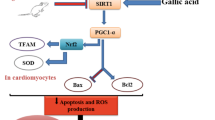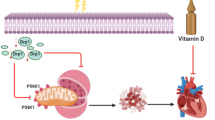Abstract
To investigate the mechanism of apoptosis in myocardial cells of aging rats induced by d-galactose and to study the effect of the Polysaccharide isolated from the seeds of Cuscuta chinensis Lam (PCCL) on apoptosis of cardiomyocytes and its corresponding machinasim in aging rat model. Fifty male SD rats were randomly divided into 5 groups. Normal control group (NC). d-galactose (100 mg·kg−1d−1 for 56 day) indued aging group (MC), d-galactose plus 100 mg kg−1 d−1 PCCL group (ML), d-galactose plus 200 mg kg−1 d−1 PCCL group (MM), and d-galactose plus 400 mg kg−1 d−1 PCCL group (MH). Same volume of solution (water, or PCCL aqueous solution) was given by gavage for 56 days. Then the hearts were collected and apoptosis parameters were evaluated. Caspase-3 and Cyt c were determined by fluorescence spectrometer, the apoptosis rate was assessed by AnnexinV-FITC method by Flow-Cytometry, [Ca2+]i and [Ca2+]i overloaded by KCL were observed by laser scanning confocal microscopy (LSCM); Bcl-2 and Bax were examined by immunohistochemistry. The content of Cyt C, [Ca2+]i of cardiomyocytes, the activity of Caspase-3, Bax expression level in d-galactose induced aging group were higher than NC (p < 0.05). The ratio of Bcl-2/Bax was decreased in d-galactose induced aging group compared to NC. On the other hand, the content of Cyt C, [Ca2+]i of cardiomyocytes, the activity of Caspase-3 and apoptosis rate, as well as Bax expression level in all three PCCL groups were decreased compared to galactose induced group (p < 0.05). Bcl-2/Bax ratio was increased in all PCCL groups compared to galactose induced aging group. PCCL could decrease the apoptosis of cardiomyocytes by the mitochondria apoptosis pathway.





Similar content being viewed by others
References
Enns LC, Wiley JC, Ladiges WC (2008) Clinical relevance of transgenic mouse models for aging research. Crit Rev Eukaryot Gene Expr 18:81–91
Zweier JL, Talukder MAH (2006) The role of oxidants and free radicals in reperfusion injury. Cardiovasc Res 70:181–190
Veinot JP, Gattinger DA, Fliss H (1997) Early apoptosis in human myocardial infarcts. Hum Pathol 28:485–492
Gottlieb RA, Burieson KO, Kloner RA, Babior BM (1994) Reperfusion injury induces apoptosis in rabbit myocardiocytes. J Clin Invest 94:1625–1629
Saraste A, Pulkki K, Kallajoki M, Henriksen K, Parvinen M, Voipio-Pulkki LM (1997) Apoptosis in human acute myocardial infarction. Circulation 95:320–323
Narula J, Haider N, Virmani R, Disalvo TG, Kolodgie FD, Hajja rRJ (1996) Apoptosis in myocytes in end-stage heart failure. New Engl J Med 335:1182–1189
Jacobson MD, Weil M, Raff MC (1997) Programmed cell death in animal development. Cell 88:347–354
Yin XM (2000) Signal transduction mediated by Bid, a pro-death Bcl-2 family proteins, connects the death receptor and mitochondria apoptosis pathway. Cell Res 10:161–167
Lin JQ, Zhang ZH, Zeng SQ (2006) TRAIL-induced apoptosis proceeding from caspase-3-dependent and -independent pathways in distinct HeLa cells. Biochem Biophys Res Commun 346:1136–1141
Cohen GM (1997) Caspases, the executioners of apoptosis. Biochem J 326:1–16
Rehm M, Düßmann H, Jänicke RU (2002) Single-cell fluorescence resonance energy transfer analysis demonstrates that caspase activation during apoptosis is a rapid process. J Biol Chem 277:24506–24514
Boyce M, Yuan J (2006) Cellular response to endoplasmic reticulum stress: a matter of life or death. Cell Death Differ 13:363–373
Yamaguchi H, Wang HG (2004) CHOP is involved in endoplasmic reticulum stress-induced apoptosis by enhancing DR5 expression in human carcinoma cells. J Biol Chem 279:45495–45502
Du XM, Kohinata K, Kawasaki T, Guo YT, Miyahara K (1998) Components of the ether-insoluble resin glycoside-like fraction from Cuscuta chinensis. Phytochemistry 48:843–850
Yen FL, Wu TH, Lin LT, Lin CC (2007) Hepatoprotective and antioxidant effects of Cuscuta chinensis against acetaminophen induced hepatotoxicity in rats. J Ethnopharmacol 111:123–128
Nisa M, Akbar S, Tariq M, Hussain Z (1986) Effect of Cuscuta chinensis water extract on 7,12-dimethylbenz[a]anthracene-induced skin papillomas and carcinomas in mice. J Ethnopharmacol 18:21–31
Hsieh TC, Lu X, Guo J, Xiong W, Kunicki J, Darzynkiewicz Z, Wu JM (2002) Effects of herbal preparation Equiguard on hormone-responsive and hormone-refractory prostate carcinoma cells: mechanistic studies. Int J Oncol 20:681–689
Chung TW, Koo BS, Choi EG, Kim MG, Lee IS, Kim CH (2006) Neuroprotective effect of a chuk-me-sun-dan on neurons from ischemic damage and neuronal cell toxicity. Neurochem Res 31:1–9
Liu JH, Jiang B, Bao YM, An LJ (2003) Effect of Cuscuta chinensis glycoside on the neuronal differentiation of rat pheochromocytoma PC12 cells. Int J Dev Neurosci 21:277–281
Umehara K, Nemoto K, Ohkubo T, Miyase T, Degawa M, Noguchi H (2004) Isolation of a new 15-membered macrocyclic glycolipid lactone, Cuscutic resinoside a fromthe seeds of Cuscuta chinensis: a stimulator of breast cancer cell proliferation. Planta Med 70:299–304
Bao X, Wang Z, Fang J, Li X (2002) Structural features of an immunostimulating and antioxidant acidic polysaccharide from the seeds of Cuscuta chinensis. Planta Med 68:237–243
Kluck RM, Bossy-Wetzel E, Green DR, Newmeyer DD (1997) The release of cytochrome c from mitochondria: a primary site for Bcl-2 regulation of apoptosis. Science 275:1132–1136
Zheng, H.Z., Dong, Z.H., She, J. (1998) Modern Study of Traditional Chinese Medicine 4110-20
Li WJ, Nie SP, Chen Y, Xie MY, He M, Yu Q, Yan Y (2010) Ganoderma atrum polysaccharide protects cardiomyocytes against anoxia/reoxygenation-induced oxidative stress by mitochondrial pathway. J Cell Biochem 110(1):191–200
Dia N, Bailly C (2005) Drugs targeting mitochondrial functions to control tumor cell growth. Biochem Pharmacol 70:1–12
Schulze-Osthoff K, Ferrari D, Los M, Wesselborg S, Peter M (1998) Apoptosis signaling by death receptor. Eur J Biochem 254:439–459
Rao RV, Ellerby HM, Bredesen DE (2004) Coupling endoplasmic reticulum stress to the cell death program. Cell Death Differ 11:372–380
Li JM, Chen YQ, Liu RG (2008) Mitochondria apoptosis and Bcl-2 family protein research progress. Med Recapitul 14:489–490
Yang E, Korsmeyer SJ (1996) Molecular thanatopsis:a discourse on the Bcl-2 family and cell death. Blood 88:386–401
Condorelli G, Morisco C, Stassi G, Notte A, Farina F, Sgaramella G, de Rienzo A, Roncarati R, Trimarco B, Lembo G (1999) Increased cardiomyocyte apoptosis and changes in pro apoptotic and antiapoptotic genes Bax and Bcl-2 during left ventricular adaptations to chronic pressure overload in the rat. Circulation 99:3071–3078
Brenner C, Cadiou H, Vieira HL, Zamzami N, Marzo I, Xie Z, Leber B, Andrews D, Duclohier H, Reed JC, Kroemer G (2000) Bcl-2 and Bax regulate the channel activity of the mitochondrial adenine nucleotide translocator. Oncogene 19:329-3
Zhou Z, Wang XH, Zhu GX, Yu ZP (2005) Relationship between hypoxia-induced apoptosis and caspase-3 activation, intracellular calcium overload in cardiomyocytes. Chin J Appl Physiol 2(11):10–14
Acknowledgments
This work was supported by Harbin Medical University. We thank Sun Hongli, Chen Yingli and Wu Mingli for excellent technical assistance.
Author information
Authors and Affiliations
Corresponding author
Additional information
Shou-Li Sun and Li Guo contributed equally to this article.
Rights and permissions
About this article
Cite this article
Sun, SL., Guo, L., Ren, YC. et al. Anti-apoptosis effect of polysaccharide isolated from the seeds of Cuscuta chinensis Lam on cardiomyocytes in aging rats. Mol Biol Rep 41, 6117–6124 (2014). https://doi.org/10.1007/s11033-014-3490-1
Received:
Accepted:
Published:
Issue Date:
DOI: https://doi.org/10.1007/s11033-014-3490-1




